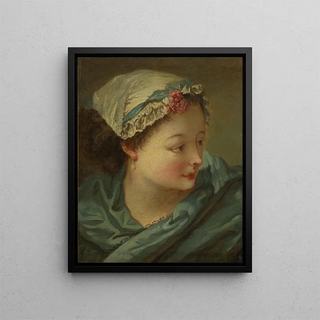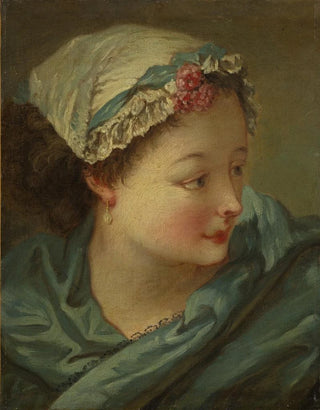Art print | Head of a young woman - François Boucher


View from behind

Frame (optional)
Enchanting French painting of the 18th century, the artwork "Tête de jeune femme" by François Boucher stands out for its delicacy and sensuality. This depiction of a young woman, both mysterious and captivating, evokes a world of refinement and beauty, where each brushstroke seems to whisper secrets of a bygone era. The soft light caressing the young woman's face, along with the subtle nuances of her complexion, invites the viewer to immerse themselves in a suspended moment, a shared intimacy between the artist and her model. The art print Tête de jeune femme - François Boucher allows for rediscovering this iconic piece, while offering an entry point into the rich and complex universe of rococo art.
Style and uniqueness of the work
The uniqueness of "Tête de jeune femme" lies in François Boucher's exceptional mastery in capturing feminine beauty both in an idealized and natural manner. The artist, known for his lush compositions and shimmering colors, succeeds here in creating an intimate portrait that transcends mere representation. The delicate features of the young woman, framed by carefully styled strands of hair, reveal a deep sensitivity, while her facial expression seems to reflect a fleeting thought. The play of light and shadow, as well as the subtle use of color, gives this work rare emotional depth, inviting the viewer to feel an intimate connection with the subject. This portrait, far from being a simple exercise in style, becomes a celebration of femininity and beauty, a tribute to the spirit of the 18th century.
The artist and his influence
François Boucher, an emblematic figure of the rococo movement, knew how to leave his mark on his era through his innovative approach to painting. Born in 1703, he established himself as one of the most influential artists of his time, particularly through his portraits and mythological scenes. His artistic vision, imbued with sensuality and elegance, profoundly influenced his contemporaries and paved the way for new forms of expression. By integrating elements of popular culture and

Matte finish

View from behind

Frame (optional)
Enchanting French painting of the 18th century, the artwork "Tête de jeune femme" by François Boucher stands out for its delicacy and sensuality. This depiction of a young woman, both mysterious and captivating, evokes a world of refinement and beauty, where each brushstroke seems to whisper secrets of a bygone era. The soft light caressing the young woman's face, along with the subtle nuances of her complexion, invites the viewer to immerse themselves in a suspended moment, a shared intimacy between the artist and her model. The art print Tête de jeune femme - François Boucher allows for rediscovering this iconic piece, while offering an entry point into the rich and complex universe of rococo art.
Style and uniqueness of the work
The uniqueness of "Tête de jeune femme" lies in François Boucher's exceptional mastery in capturing feminine beauty both in an idealized and natural manner. The artist, known for his lush compositions and shimmering colors, succeeds here in creating an intimate portrait that transcends mere representation. The delicate features of the young woman, framed by carefully styled strands of hair, reveal a deep sensitivity, while her facial expression seems to reflect a fleeting thought. The play of light and shadow, as well as the subtle use of color, gives this work rare emotional depth, inviting the viewer to feel an intimate connection with the subject. This portrait, far from being a simple exercise in style, becomes a celebration of femininity and beauty, a tribute to the spirit of the 18th century.
The artist and his influence
François Boucher, an emblematic figure of the rococo movement, knew how to leave his mark on his era through his innovative approach to painting. Born in 1703, he established himself as one of the most influential artists of his time, particularly through his portraits and mythological scenes. His artistic vision, imbued with sensuality and elegance, profoundly influenced his contemporaries and paved the way for new forms of expression. By integrating elements of popular culture and






